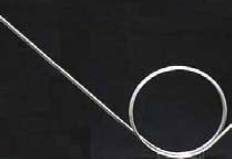Hints for the Lab "Roller
Coaster of Statistically Likely Doom"
This lab is another
of our "use-the-physics-you-know-to-make-a-prediction-and-the-best-one-wins-a-prize" labs.
In it, you will be shown the loop-the-loop apparatus that will be used
for the competition in the second week. It looks something like shown on
the right. Your goal is to roll a golf ball down the incline so that it
completes the loop without leaving the track. Clearly, the higher up you
start on the incline you start the ball, the faster it will go round the
loop and so the more certain it will be to stay on the track.
The team that keeps their test ball on the track and starts at the LOWEST
height will win two bonus points on their lab.
You will be allowed to make measurements on it before the competition,
but only static ones -- radius of the loop, angle of the incline, etc.
You will NOT be allowed to run a test on it before the competition. |
 |
You can get a pretty good idea of where to start by using energy conservation
and the centripetal force rules. These are sketched at the bottom of these
hints.
The law of mechanical energy conservation we wrote down in class assumes there
is no energy lost to friction and no other forms of mechanical energy available
other than kinetic energy and gravitational potential energy (or spring PE,
but there is none here). That is likely not to be very accurate for this apparatus.
It might be pretty good, but understanding the deviation from the ideal is
where this competition will be won!
During the first week you will be given pieces of track of the same material
as the competition apparatus. Your job is to determine how close the apparatus
comes to the ideal and to figure out a way how to extrapolate your measurements
to the large apparatus on which you will be competing. Be sure to document
your hypotheses and how you test them for your lab report!
One of the components of
your test will certainly involve a measurement of the speed of your ball
after it has rolled down a piece of track from a certain height. A good hint
at how to do that is to let the ball roll off the end of the table and use
the relation between height, distance traveled off the edge of the table,
and speed that you needed for the previous lab ("No such thing
as free launch.") This is also outlined briefly at the bottom of this
hint.
Mathematical Hints
1. The centripetal rule of circular motion
When an object is traveling along a circular arc, its velocity is changing
direction. Newton's second law tells us that this changing the direction of
velocity requires a net force. We will work out in lecture that if an object
is changing its direction on a circular arc of radius R and is moving
with a velocity v, then changing its direction requires a net force
that points towards the center of the circle and has a magnitude
Fnet = mv2/R
When the ball is at the top of the loop, the net force is a combination of
gravity and the normal force of the track pushing it down. If the speed is
too slow, the ball will need a net force that is smaller than that provided
by gravity alone. This would mean that the track would have to pull up on it.
A track can do this on a cart with rails, but not on our golf ball. If the
velocity is so slow that it need N from the track to point up, it will
fall off. From this, you should be able to figure out the criitical speed.
2. Velocity of a
ball rolling off a table
If a ball rolls off a table
with a velocity, v0,its motion will be
determined by Newton's second law (N2) with the net force given by gravity
alone (free fall). Since N2 is a vector law, it means that the acceleration
in the x direction and the y directions are determined by the
forces in the x and y directions.respectively. Since there is no force in the
x direction, the x velocity, initially equal to v0, will remain the
same. The horizontal distance traveled by the ball before it hits the ground
will depend on how long it stays in the air. This is determined by the y-motion.
It starts with 0 y-velocty and accelerates downward due to the force of gravity.
If the height of the table is h, we want to develop an equation that
tells us the distance, d, the ball will travel before it hits the ground.
We therefore want to find an equation for v0 that expresses it in terms
of h, d, and g (and nothing else). This is fairly straightforward
to do if you
- Write N2 for the x motion and the y motion.
- Write the definitions of average x velocity and y velocity and accelerations
- Put in the specific symbols corresponding to this particular case (initial and final positions and velocities)
- Eliminate the Δt from your equations to get the desired relation for v0 as a function of h, d, and g.
